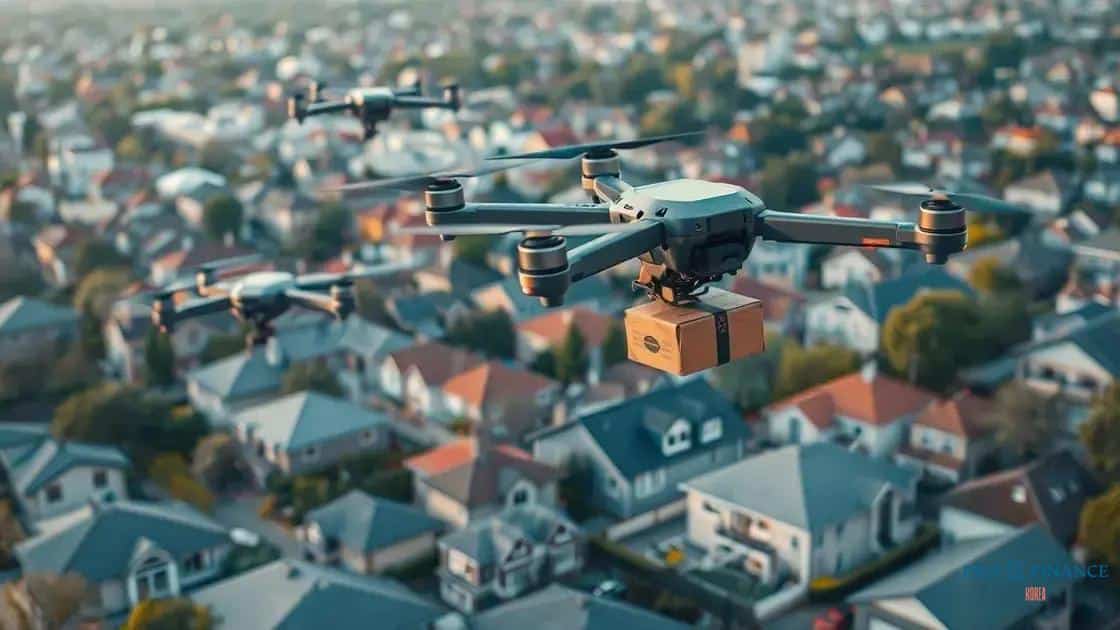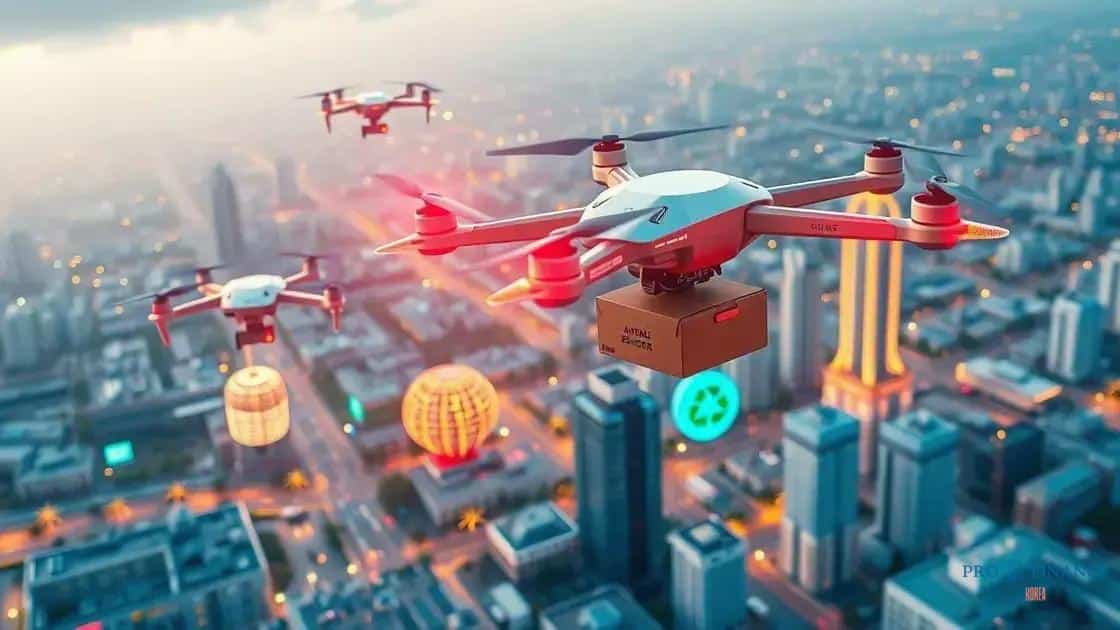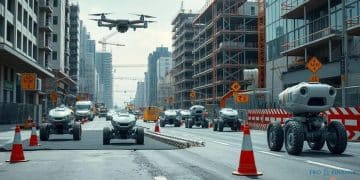Advances in autonomous drones for delivery services

Advancements in autonomous drones for delivery services are transforming logistics by providing faster and more efficient package delivery, while facing challenges such as regulatory compliance and safety concerns in urban environments.
Advances in autonomous drones for delivery services are not just about flying boxes around. They represent a leap in how we think about convenience and efficiency in logistics. Have you ever wondered how these drones might change your daily life?
The technology behind autonomous delivery drones
The technology behind autonomous delivery drones is fascinating and constantly evolving. These flying robots are designed to transport packages without human intervention, relying on advanced technologies for navigation and operation.
One of the key technologies is GPS. Drones use GPS to pinpoint their location and determine their flight path. This ensures they can travel efficiently and reach their destination accurately. Another critical component is the onboard sensors.
Key Technologies Used
These sensors help the drones detect obstacles and changes in the environment. They work in tandem with cameras and LIDAR systems, allowing drones to navigate safely.
- GPS for precise navigation
- Onboard sensors to avoid obstacles
- Cameras for real-time data collection
- LIDAR for mapping and environmental detection
In addition, artificial intelligence plays a vital role in autonomous drones. AI algorithms process data from sensors and enable drones to make decisions during flight. For instance, if an obstacle is detected, the drone can automatically adjust its path to avoid it.
Battery technology is also crucial. Innovations in battery life allow drones to cover longer distances while carrying heavier payloads. With longer runtimes, these drones are becoming more efficient in delivering goods over vast areas.
The Future of Drone Technology
The future of autonomous delivery drones looks promising. As technology advances, we may see faster delivery times and expanded usage in urban environments. With regulations evolving alongside technology, the potential for widespread adoption is increasing.
Current applications in logistics and delivery

Current applications in logistics and delivery using autonomous drones are redefining how goods are transported. These drones are becoming invaluable for various industries, making deliveries faster and more efficient.
One of the most prominent uses is in package delivery. Companies are deploying drones to transport small parcels directly to customers’ doorsteps. This is especially popular in urban areas, where traffic delays can hinder timely deliveries.
Healthcare Innovations
In the healthcare sector, autonomous drones are making significant impacts as well. They are used to deliver medical supplies, blood, and vaccines to remote or hard-to-reach locations. In emergencies, these drones can significantly reduce delivery time, which can be critical in saving lives.
- Transporting vaccines during health crises
- Delivering medical supplies to remote clinics
- Rapid transportation of blood and organs
Another application is in food delivery. Restaurants and food delivery services are beginning to experiment with drones. By using aerial delivery, they can reach customers quickly, especially in crowded areas. This not only enhances customer satisfaction but also expands the delivery radius.
Retail Logistics
Retail companies are also embracing drone technology. Major retailers are testing drone delivery systems to enhance their logistics operations. By integrating drones into their supply chain, retailers can achieve quicker restocking of inventory.
Challenges facing autonomous drone delivery
There are several challenges facing the successful implementation of autonomous drone delivery. As technology progresses, understanding these obstacles is key to ensuring safe and efficient operations.
One major challenge is regulatory approval. Governments around the world are still adapting their laws to accommodate drone technology. Each country has its own set of rules, which can complicate operations for companies looking to implement drone delivery on a large scale.
Safety Concerns
Another significant issue is safety. Drones must be able to navigate safely through urban environments, avoiding obstacles such as buildings, power lines, and other aircraft. In addition, there are concerns about potential accidents and how they might impact the public.
- Potential for crashes in crowded areas
- Emergency landing protocols
- Public perception and acceptance
Furthermore, privacy concerns are prevalent. Drones equipped with cameras and sensors can unintentionally invade personal privacy. Addressing these concerns is vital for gaining public trust and acceptance.
Technical Challenges
From a technical standpoint, ensuring drone reliability is crucial. Drones face many physical challenges, such as weather conditions. Rain, wind, and snow can hinder their ability to navigate effectively. Therefore, drones must be equipped with robust technology to handle various weather situations.
Future trends in drone delivery services

The future trends in drone delivery services indicate a shift toward more advanced and widespread usage. As technology continues to improve, we can anticipate significant changes in how packages and goods are transported.
One key trend is the expansion of delivery networks. Companies are investing in infrastructure that supports drone operations. This includes designated delivery zones and charging stations for drones, allowing for faster and more efficient service.
Integration with Other Technologies
Moreover, we will likely see greater integration of drones with other delivery methods. For instance, combining drones with ground vehicles can enhance the efficiency of last-mile delivery. This hybrid approach allows drones to cover large distances while ground vehicles handle the final delivery phase.
- Using drones for shorter, urban deliveries
- Ground vehicles delivering to hubs for drone pickups
- Real-time tracking systems for better transparency
Additionally, the use of artificial intelligence will shape the future of autonomous drones. AI can improve route optimization, allowing drones to determine the best paths in real-time. This not only saves time but also reduces energy consumption. As drones become smarter, they can handle more complex deliveries.
Environmental Considerations
Environmental impact is another area of focus. Future drones are expected to be more eco-friendly, utilizing sustainable fuels or electric power to minimize their carbon footprint. This shift aligns with global efforts to reduce emissions and promote greener technologies.
Regulations and safety considerations in drone usage
Regulations and safety considerations in drone usage are essential for ensuring safe operations. As drones become more common in various sectors, it is crucial to have clear guidelines that govern their use.
Many countries have established specific rules that dictate how and where drones can operate. These regulations often require pilot certification, ensuring that operators understand how to fly drones safely. Knowledge of airspace restrictions is crucial for preventing accidents.
Airspace and Flight Restrictions
Drone operators must also be aware of restricted airspace. Certain areas, such as near airports or sensitive sites, have regulations that prevent drones from flying. These rules help protect both drone flights and manned aircraft.
- Mandatory registration of drones with aviation authorities
- Altitude limits for drone flights
- Visibility requirements during operations
In addition to regulations, safety considerations are paramount. Operators must conduct thorough pre-flight inspections to ensure that their drones are in good condition. Battery life, propeller integrity, and software updates are vital aspects to check before each flight.
Emergency Situations
Operators must also be prepared for emergency situations. Knowing how to safely land a drone in case of technical failure or sudden weather changes can prevent accidents. Establishing emergency protocols enhances safety and reduces risks for people and property on the ground.
FAQ – Frequently Asked Questions about Autonomous Drones for Delivery Services
What are the main benefits of using autonomous drones for delivery?
Autonomous drones provide faster delivery times, reduced traffic congestion, and the ability to reach remote areas more efficiently.
What regulations should drone operators be aware of?
Drone operators must comply with airspace restrictions, obtain necessary certifications, and ensure safety measures are in place.
How are drones improving healthcare deliveries?
Drones are used to deliver medical supplies, vaccines, and blood to remote locations quickly, enhancing emergency response times.
What challenges do autonomous drones face in urban areas?
Challenges include navigating crowded environments, adhering to safety regulations, and public concerns regarding privacy.






